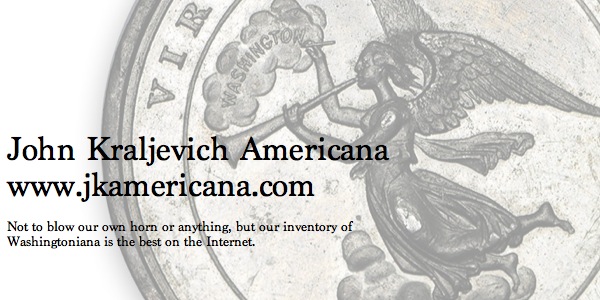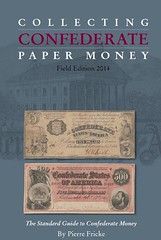
PREV ARTICLE
NEXT ARTICLE
FULL ISSUE
PREV FULL ISSUE
BOOK REVIEW: COLLECTING CONFEDERATE PAPER MONEY, 2014
John and Nancy Wilson submitted this review of the new edition of Collecting Confederate Paper Money, Field Edition 2014, by Pierre Fricke. Thanks!
-Editor
This new reference on Collecting Confederate Paper Money, Field Edition released in January, 2014 by Pierre Fricke updates his Field Edition published in 2008. This 2014 edition is hardback (6X9), in full color with 576 pages. It has new updated prices, which include slabbed pieces from PMG and PCGS and includes an excellent blueprint for each type. It also includes pricing for the Trans-Mississippi reissued notes along with the easy to use, “type picture ID appendix for beginners,” with updated commentary on the market, and an improved photo grade section. Pierre Fricke explains the different updates in this book from the 2008 reference. He discusses his purchases using the old Grover Criswell reference and learning from Dr. Douglas Ball and others. The Market in 2003-2013. Pierre Fricke takes you through the ups and downs of the market during these years. He said he sold his CSA type collection in 2004 and that the market was weak in 2005. When his reference “Collecting Confederate Paper Money” was released in 2005 it changed the market. His market analysis comes from coin shows, auctions, price lists and interaction with other collectors and dealers. The “Story of Collecting Confederate Paper Money,” by Stephen Goldsmith, is a repeat of the information that was contained in the 2005 Pierre Fricke reference. Mr. Goldsmith reminisces about his close friendship and working alongside Dr. Douglas Ball and others. After Dr. Ball passed away, Goldsmith brought in Pierre Fricke to help catalog the Gene Mintz collection of Confederate notes. The author covers several ways of collecting such as a Type Set which would consist of one example of each of the 70 officially-issued major types. He feels that before you buy your first note you should have certain references and he covers them. He also thinks you should consider your goals, join paper money organizations and most importantly learn about modern fakes and bogus notes and others. Mr. Fricke covers the catalog systems that were used in the 19th Century and discusses the numbering systems of Chase, Criswell, Bradbeer and how this reference is needed if you are going to collect CSA notes. The issue series explains the Acts which approved the seven different Series of CSA notes that were issued. Notes of a particular type all share a single major design, date of issue and denomination combination, and is indicated by a “T,” followed by the number. This is the Criswell type numbering system. The few possible types that are unknown are mentioned along with the comment that there have been no new type discoveries in many decades. Fricke defines varieties as a unique combination of differentiated obverse plate and paper types. He says that, literally thousands of minor differences will be found within the types and varieties of CSA money. This reference focuses on significant historical and new varieties. Minor variations are beyond the scope of this work. The author summarizes the “major new varieties” such as the new Wookey Hole Mill watermark, Whatman wartermark, and inverted back discoveries. Printing and Man-Made Errors explains what these interesting errors are. The few different types of paper employed by Confederate printers are also listed. Watermarks are words, numbers or symbols embedded into paper to help deter counterfeiting. Nine enlarged figures show you what the watermarks will look like when held up to a light. Information on the companies that produced the notes along with the firm's biographies is given. The three methods that printers used to print notes are lithography, typography and intaglio which are covered under plate layouts. Collecting Sheets of Confederate Notes explains how sheets were made and how they are graded. He discusses how counterfeit notes were produced as souvenirs or to be placed in circulation as the real thing to disrupt the CSA finances. The types of dangerous counterfeits are listed along with their creators. Some backs are printed on genuine Confederate notes that are believed not to be contemporary to the period. The author then explains that these (backs) were added by various third parties after the war for purposes mostly unknown. Modern Facsimiles and Bogus Issues, Advertising Notes and Confederate Bonds close out this section. Facsimiles were created during the War and are known as contemporary counterfeits. The “Confederate Treasury” publishes a type set of CSA notes that the author says has a remarkable likeness to real money and will help you compare your notes to the examples on their pages. The site is located at: www.confederatetreasury.com. After the war, many merchants printed advertising on the back of the uniface notes. The author says that around 1900, facsimiles of Confederate paper money with advertising began to appear and are readily discernible from real Confederate paper money. Confederate bonds mentions that Dr. Douglas Ball published the landmark Comprehensive Catalog and History of Confederate Bonds in 1998. Pierre Fricke includes an updated rarity and price guide for Confederate bonds in Appendix A. The Two Dimensions of Grading and Technical Grading. Taken together, the author explains the technical part of grading which is the state of a note due to circulation and the other is eye appeal such as, folds, tears, badly trimmed, ink burns through notes, stains, repairs, alterations or other impairments. Collector-Oriented Grading and Market-Oriented Grading is explained. The collector-oriented grading is designed to differentiate notes, especially at the high end, so that collectors get a clear picture of the note. The market-oriented grading will tend to push notes up the grading scale anywhere from half, to one and a half grades, though it also may yield the same grade as collector oriented grading in some cases. PCGS, PMG and other grading services are covered with illustrations (face and back) of notes from gem uncirculated new 66 to Very Good 8 and what to look for in determining the grade of the note. Condition Qualifiers describe the eye appeal and overall appearance of a note. Cancelled Notes are illustrated along with the kinds of cancellations. Condition Census – The “Top Guns” covers a listing of the finest known examples by type and variety in a ranked order. A rarity table from R-1 100,000+ known – very common right up to R-16 (None Seen and None seen in living memory) is given. Rare varieties would be represented in Rarity 10 to 16 and Non Collectibles designation is something all of us wish we would find. A price guide for PCGS and PMG graded notes is included in this reference. The fascinating venue of Ebay for purchasing and selling, and their policies including grading are talked about. Collecting Confederate Paper Money Today – A Closer Look covers the different ways people are collecting CSA paper money and costs associated with putting together a 70-note type set. Some collectors assemble an 1864, 1863 or 1862 Type Collection(s) or a 64 Major Type Note Collection. The “Great Rarity” Collection is also mentioned and the author states nobody has yet completed this set. Trans-Mississippi Re-Issues is a well done section that gives you all the available information on them. Several enlarged illustrations will also help you to determine if any of your notes have the Re-Issued stamp and or if you want to collect them what to look for. Mysterious Date Stamps and the Trans-Mississippi explains the red date stamp which will be found on these notes. The Trans-Mississippi Catalog and Values for the known types is given. The Summary of Ways to Collect CSA Paper Money gives the reader the approximate number of people who completed their sets. One way is a type set of Dec. 1862, April 1863, or Feb. 1864 series. THE CATALOG contains the 70 different regular issue types along with the two mysterious “fantasy” notes and is the “nuts and bolts” of this reference. It contains the most comprehensive list of Confederate currency. For all 72 Types you will find, authorization dates, excellent illustrations, known serial numbers, collector and market prices, rarities, dates, grades, tips, survival rates, and grading service prices (from VG to Unc). Appendix A – Confederate Bonds contains Grading CSA Bonds and Trans-Mississippi Bonds. The only other reference that lists Confederate bonds is the Dr. Douglas Ball reference which was published by BNR Press in 1998. Mr. Fricke updates that reference with current values in conditions from good and very good up to extra fine. The Ball and Criswell numbering system have the prices given along with a Fricke Rarity guide. Appendix B – Pages from Dr. Ball’s Original Manuscript. These four pages out of the 300-page manuscript represent some of Dr. Ball’s research on Confederate paper money. Appendix C – A comparison of grading styles. The columns have the grade presented and style of grading. Appendix D – A variety number cross-reference. All the Criswell and Fricke Type numbers are listed along with the number’s which have been delisted. Appendix E - Quick Finder The face of all the types are illustrated in color, including the fantasy female riding reindeer. About the Author – Pierre Fricke After 35 years as a collector and dealer is considered an expert in the field of Confederate paper money. He also has collected in other fields including Fugio cents by Newman number, 1796 cents by Sheldon variety, Civil War-era US large type notes, and others. The reference is well laid out in an easy to read and understand manner. We know that our small type collection of CSA paper money will now have new numbers and current prices placed on the holders. The price postpaid is $40, and you can ask for a personalized and signed copy. For information on purchasing this reference, you can contact the author: Pierre Fricke, P. O. Box 1094, Sudbury, MA 01776 or visit www.csaquotes.com or Email – pfricke@csaquotes.com

Wayne Homren, Editor The Numismatic Bibliomania Society is a non-profit organization promoting numismatic literature. See our web site at coinbooks.org. To submit items for publication in The E-Sylum, write to the Editor at this address: whomren@gmail.com To subscribe go to: https://my.binhost.com/lists/listinfo/esylum All Rights Reserved. NBS Home Page Contact the NBS webmaster 
|
